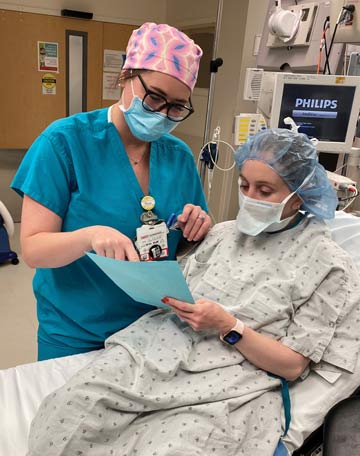Each member of the surgical team must be actively involved in the time out. Giving every team member a specific role can help lessen their fear of speaking up if a potential problem is detected, and also emphasizes the importance of the process.
"Everyone needs to pay attention, feel empowered to speak up and have confidence that their voice will be heard," says Ms. Vance.
Fear of speaking up in the operating room when something seems amiss is a real issue, so creating a culture where everyone feels comfortable doing so is imperative. "We utilize a high five system, where the team member who speaks up during
the time out receives an email that says, "Thanks for keeping Penn Medicine safer,'" says Ms. Vance. "Their managers also receive the message and it's seen by the rest of the staff. Seeing the messages encourages them to pat their colleagues
on the back and let them know their catch was important and valuable."
The emails are also shared with surgical leadership during staff meetings. "It's another forum where we can recognize the staff member for their efforts," says Ms. Vance.
It's important to designate a specific team member to lead the time out, according to Tamala Proctor, MSN, RN, CCRN, a clinical nurse education specialist at Penn Hospital. "It should be someone who can refer to the consent form in the chart
in order to ensure that what's noted on it matches the patient identifiers verbalized during the time out," says Ms. Proctor. "They can also use the form to confirm correct answers to questions members of the surgical team have about the
procedure or patient."
Giving every member of the surgical team a role to fill during the time out ensures everyone in the room feels comfortable speaking up. It also ensures every team member will be active participants in the time out.
If the circulating nurse initiates the time out, they must confirm the patient's name, date of birth, medical record number, allergies and the procedure about to be performed. "The circulating nurse must also make sure the patient is positioned
correctly, and that the surgical site marking is visible," says Ms. Proctor.
The anesthesia provider must also confirm the patient's name, date of birth and medical record number. They should announce the time of antibiotic administration and blood products that are needed, and alert the team to any airway concerns.
Finally, the entire surgical team must verbally agree on the procedure that's about to be performed.
You shouldn't need to resort to attention-getting devices or tricks in order to get the team focused for the time out. "Whoever has been given the role to initiate it should simply say, 'We're ready to start,'" says Ms. Proctor. "The process
should become enculturated, so that it becomes automatic as soon as the entire team gets to the operating table."
Still, you might have to manage push back from members of the surgical team who don't appreciate or fully understand the importance of the pre-op time out. "I was auditing a time out and one provider refused to stop was he was doing and take
part," says Ms. Proctor. "He became visibly frustrated and expressed his displeasure when I told him to participate."
The time out should become enculturated so that it becomes automatic as soon as the team gets to the operating table.
— Tamala Proctor, MSN, RN, CCRN
The provider still refused to take part, even after Ms. Proctor's warning. She escalated her concerns about the provider up the chain of command and the hospital's leadership fully supported her efforts to engage the provider, and made sure
he was an active participant in the time out process moving forward. The lesson here is that enforcing frontline practices sometimes requires support from the top.
.svg?sfvrsn=be606e78_3)

.svg?sfvrsn=56b2f850_5)